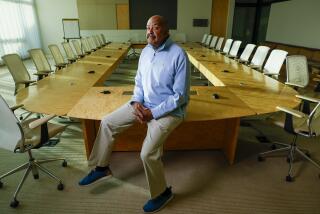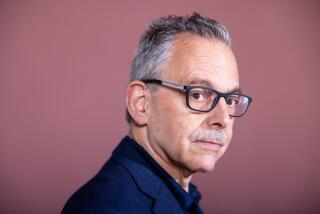Taking It to the Main Streets
- Share via
UCLA professor and pediatrician Neal Halfon wasn’t expecting Al Gore’s call at home last week--nor did he expect the former vice president to schedule his first day as an academic today on the Westwood campus. The two had last talked in June 1999 at an annual family issues conference sponsored by Al and Tipper Gore in Tennessee. As it turned out, those conversations would spin each of them down an unexpected career path.
Last week, Gore, 52, announced plans for a stint in academia that will include a foray into a new field called “family-centered community building.” At an invitation-only, one-day UCLA symposium, Gore will work with a national consortium of experts to develop a curriculum for the subject. Gore plans to teach courses on community building at Fisk University in Nashville and Middle Tennessee State University in Murfreesboro, based on the consortium’s findings. He also will lecture at UCLA’s School of Public Policy and Social Research--the topics are not yet decided--and on politics and media at Columbia University’s Graduate School of Journalism in New York. Gore has no formal teaching experience. He graduated from Harvard University in 1969 with a degree in government and attended divinity school and law school at Vanderbilt University before a short career as a journalist. So how did he happen to dive into family-centered community building? Gore has given few details, steering reporters to Halfon, who, with his academic partners, has been developing the concept since mid-1999. The idea, Halfon said, is simple: bind universities and communities together in ways that strengthen families. Traditionally, such efforts have focused on economics: how to improve lives by bringing jobs and investment into communities.
Halfon and his colleagues set out to recruit campus experts--psychologists, architects, pediatricians and others--to look at ways to meet community needs.
The experts would look at ways to teach the subject, perhaps as an independent discipline so students eventually could earn degrees in community building. They would encourage top graduates with MBAs and other advanced degrees to work in lower paying, less prestigious community centers and programs for a couple of years, then possibly return to campus for temporary teaching stints.
In mid-1999, Gore first jumped on the idea of university-led research in the field, Halfon noted. Gore turned to Halfon, director of UCLA’s Institute for Children, Families and Communities, for help. The institute unites an array of specialists with community groups and others to explore ways to improve the health and well-being of children, families and communities.
“So here I am, a pediatrician, and someone who works on community health issues for children, and now I’m running this national consortium,” said Halfon, 49, a married father of two small children, who, even at the end of a full day, looked unfazed in a pressed suit jacket and tie. “It was a little bit of a step in a direction . . . that I wasn’t expecting to take.”
Halfon joked that he should not have spoken up during a dinner meeting at the vice president’s residence in Washington, D.C. Gore’s staff had invited 30 advisors in different fields to the meeting preceding the Family Re-Union conference in June 1999 at Vanderbilt University. Halfon, a well-known expert on health care for children, was seated at Gore’s table. In a discussion about community leaders, someone threw out a question: Why aren’t universities training more students to work in community settings such as YMCA gyms or 4-H clubs? (Only a few institutions offer classes in community building, such as Cambridge College in Massachusetts, which has developed a two-year curriculum for training community leaders).
Halfon jumped in. In fact, he said, UCLA and several other universities had been working on ways to take more active roles in their communities.
Various departments at UCLA, for instance, organize programs through the Hope Street Family Center at California Hospital Medical Center in downtown Los Angeles, which provides services to families with very young children. Since 1991, the School of Public Policy and Social Research has worked with community and labor activists through the family center. In a yearlong free program, community participants pick an issue and conduct research with UCLA graduate students. Their projects have led to the formation of the city’s first African American garment industry association and a bilingual workshop on money and banking issues that has been replicated by other community organizations.
The UCLA School of Arts and Architecture sends graduate students into elementary schools to teach classes on world music. And eight times a year, the campus’ biomedical library staff sponsors programs for the public to read and discuss famous medical writings and to study the relation of medicine to the culture.
Gore was intrigued. Halfon remembers Gore turning to him and asking him for help organizing such efforts on a national scale. We’re doing a good job of sending our university graduates from our business schools and law schools and public policy schools to Wall Street or to the dotcoms or to Disney or the federal government, Gore told Halfon, but we’re not doing a good job of sending those same individuals to main streets and inner cities where there’s a lot of need for their expertise.
Halfon took the vice president’s suggestion to heart, though he was busy teaching and researching issues involving children, such as brain development and the kinds of services provided to abused youngsters in foster care. After the Family Re-Union conference, Halfon and other academics began meeting to explore how to take community building in a new direction.
A loose alliance of 15 universities, called the National Academic Consortium, emerged to work on the concept, including Howard University in Washington, D.C., the University of Michigan in Ann Arbor and UC Berkeley.
For 1 1/2 years, Halfon, along with other UCLA faculty and staff, has worked with consortium members to develop curriculum and projects. Because the consortium had no formal plans or even a timetable, none of its members even approached funders. No one took much notice of them until last week, when Gore mentioned to reporters his plans to use the work of Halfon and the consortium in his teaching.
Just before the announcement, Gore and Halfon had talked several times by telephone. “He said he really wanted to return to issues that he cared most deeply about, which were issues about families,” Halfon recalled.
Details on Gore’s involvement with UCLA and the consortium are still being worked out. Gore never asked about a potential stipend, said Halfon. Instead, the former vice president said, “I’m ready to start. How about next Wednesday?”
More to Read
Sign up for Essential California
The most important California stories and recommendations in your inbox every morning.
You may occasionally receive promotional content from the Los Angeles Times.










